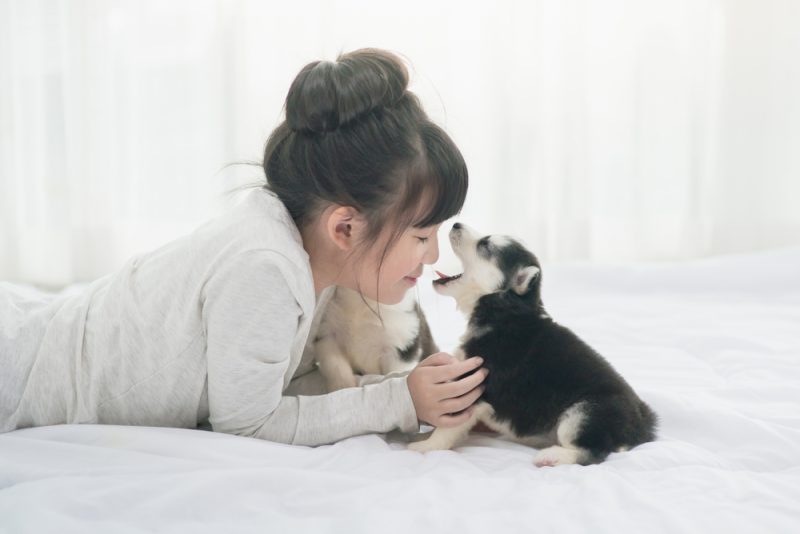No matter how well you plan, every baby comes with an adjustment period, and it isn’t just the parents who feel the immediate stress of a growing family. When dogs sense the multiple changes a new baby brings, this leads to feelings of insecurity and causes them anxiety.
The unpredictable screaming and up-all-night behavior are startling and confusing enough, but the overall upheaval in the routine can make pets feel forgotten as your attention shifts to the latest addition to the family.
Even with the most adaptable dogs, the ensuing mood and behavioral changes can seem almost impossible to avoid. Ease your pet’s stress and promote a stronger bond among all your children with these five tips when you start to see signs your dog feels neglected.

The 5 Ways to Help When a Dog Feels Neglected After You Had a Baby
They may not get along initially, but your dog and baby have more in common than you may realize. Dogs develop infant-like attachments and want to stay as close to their caregiver as a baby does to their mother.
Separation is stressful. New routines cause unpredictability, leading to anxiety and insecurity. Even if you assure yourself your dog won’t lose any attention when your baby comes along, they will see and experience changes around them. It’s unavoidable.
Your job will be to soften the blow. Some aspects of life with a baby are controllable, while others will make you fight to ease their effect on your dog. Babies are full of surprises, so don’t expect a 100% seamless transition.
Patience is more crucial than anything. It could take weeks or several months, but with the proper approach, your dog and baby will develop a positive connection, leading to a long-term, familiar relationship
1. Nurture Your Bond Daily
Maintaining a reasonable schedule and giving your dog large chunks of one-on-one time after bringing home a baby isn’t easy or even possible in many instances. Since you can’t always allot 15+ minutes of play in a predictable daily schedule, you’ll have to fill what few gaps you have in the day with attention to make up for it.
Keep a ball or tug rope handy to engage your dog when the baby gives you some downtime. These little sessions add up throughout the day, even if it’s only for a few seconds. Your dog will see that even though the situation may have changed, you’re still as present as ever.

2. Give Your Dog a Safe Space
Babies are small bundles of sensory overload, especially for dogs that don’t have experience with them. When the crying and screaming become too much, they’ll appreciate a comfortable, familiar space to escape the madness.
Create a hangout spot in a separate room away from the action, giving your dog a soft bed and some of their favorite toys and blankets to keep them cozy and content. Ideally, this should be done months ahead of the baby’s arrival, so your dog is used to the space as being their special safe area and doesn’t feel displaced because the baby arrived.
If your dog has a positive history of using this special retreat, they will naturally gravitate toward it when they need a break, so planning can help a lot. But if it’s too late for that, then ensure the area is cozy, extra comfortable, and paired with good experiences. By that, we of course mean high-value treats; just ensure they are provided when your dog is chilling out there, not when they are stressed.
3. Walk Your Dog and Baby
Finding positive moments to share with your baby and dog will help them build their bond. If your dog happily engages in their favorite activities while your baby is present, they can develop a favorable association with their new family member.
They won’t see competition for resources but instead will see a novel detail that is also included in the fun activities. Your equipment will be essential in keeping your baby safe and your dog under control while walking the two.
Leash-trained and well-mannered dogs are manageable, but if you have a large dog that likes to roam, you’ll need a sturdy stroller that is easy to steer, stable against bouncing, and can turn rapidly. Jogging strollers are an excellent choice, or you could try a wearable setup to keep both hands free for your dog. We do not recommend the use of retractable leashes while having a baby and a stroller. Alternatively, bring a second person to make this process easier.

4. Provide Ongoing Enrichment
A collection of fun chews, puzzle toys, and other stimulating equipment will keep your dog physically and mentally engaged, letting you focus on other parenting duties without making them feel neglected.
Maintaining a fresh rotation of new devices will maximize your dog’s interest. Of course, driving to the pet store is one of many chores that become more demanding when you have a baby.
If it feels exhausting, subscription boxes can be an enormous help. Rather than run to the store, you can get goodie boxes delivered straight to your door from BarkBox, Pooch Perks, and similar services.
Each month brings new toys and treats to excite your pup. Shop around for low-priced trial periods. With 3–6 months of affordable boxes, you can likely satisfy your dog during that crucial adjustment period as they get used to the new routine with the baby.
5. Find Help
Keeping your dog from feeling neglected after you have a baby takes effort. You’ll have to put off some favorite downtime activities, wake up a little earlier, and move faster to keep everyone happy. It sounds stressful, but if you know where to look, you’ll find sensible options to earn some much-needed relief.
Don’t be afraid to lean on others, whether it’s a friend, family member, or local service. Check reviews and pricing for doggy daycares near you. They can ease the burden in several ways, whether you need grooming help or want to keep your dog entertained even on your busiest days.
Daycare visits will do more than save time. Socializing opportunities expose your dog to new situations and sensations, helping them learn to stay calm and develop better behaviors. More importantly, they’ll get the attention they deserve but can’t always get from an owner with a baby.


Conclusion
Parenting isn’t easy and becomes exponentially more challenging with every child added to the family. You and your pet deserve some grace. You’ll learn from mistakes and discover new ways to meet your dog’s needs, but they will inevitably feel some stress with a changing household.
Remember, if you start to see signs that your dog feels neglected, stay positive and patient through the trials and your dog will build an exceptional bond with your baby they’ll enjoy for years.
See also:
- How to Teach a Dog to Respect Children: Vet-Approved Ways
- How to Socialize a Neglected Dog: Vet-Approved Tips & Tricks
Featured Image Credit: Iryna Imago, Shutterstock




















